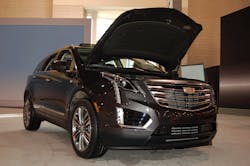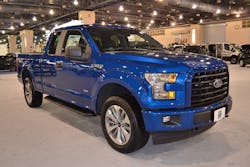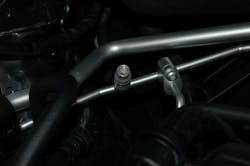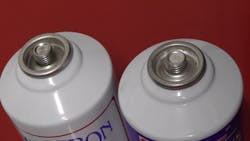We’ve reached another milestone in the mobile A/C refrigerant timeline, and this time it’s a big one: January 1, 2017 was the drop-dead date set by the EU (European Union) for when vehicle manufacturers can no longer fill any new vehicle’s A/C system with fluorinated refrigerants (or F-Gases) that have a GWP rating of more than 150. This totally knocks out R-134a as a player (with its relatively high 1,430 GWP), pretty much leaving OEMs with a choice between R-152a, R-744 (what we call carbon dioxide when it’s used as a refrigerant) or R-1234yf, which is quickly becoming the new world standard.
If possible, car makers around the world would still like to employ just one, universally accepted working fluid (the refrigerant), which is one reason why R-1234yf has so much support (that, along with its GWP of 1 and its similarities to R-134a, among others). All OEMs will build yf systems to meet the current EU and upcoming US and other world regulations, but it’s not the only fluid in development right now.
Tata Motors in India is working on a “Secondary Loop” system with MAHLE Behr Troy (formerly Delphi Thermal Systems) and the IGSD (the Institute for Governance & Sustainable Development) that uses R-152a (the same chemical used in those cans of computer dust off spray), and we expect to learn more about that as 2017 progresses.
But probably the most well known is Daimler’s work on R-744 systems, which they have said will be available on certain vehicles for the 2017 model year. In fact, there were several meetings and discussions about the technology at the recent EAAC (European Automotive A/C Convention) in September 2016, including a demonstration of R-744 R/R/R machine technology on an actual vehicle.
R-1234yf at the 2017 PHL Auto Show
In the meantime here in the US, we continue to see more vehicles on the street using R-1234yf refrigerant, and as expected the 2017 model year has extended HFO’s reach into several more models than ever before. January 27 was Media Day at the Philadelphia Auto Show, and MACS was there to check out the new models, open 100+ hoods, and see what the OEMs are doing with their A/C systems. We were not surprised to see more vehicles using the new refrigerant, but we really didn’t expect to see as many as we did. I myself thought there would be some increased expansion within a few carlines, but we found it in close to half of the vehicles we saw on the floor. In fact, we calculated recent surveys at about 48%!
Several newcomers brought yf to the show, including brands like Subaru, Kia, Chevy and Buick. So far Subaru has only changed over their flagship Legacy sedan and Outback wagon, while Kia is using it in the Optima and Sportage. We also checked out FCA and as expected almost every vehicle on display uses yf. Not surprising, considering they changed over most products during the 2015 model year. But there are still a few holdovers like Caravan and Patriot, expected to be phased out of production soon.
As for the GM brands, technicians know that when a change is made to one specific model, changes to their sisters are not far off. For example, MACS reported back in August about GMC putting yf in the Acadia, and now we’re also seeing it in the Cadillac XT5 (Figure 1). Same goes for the Chevy Silverado 1500 and GMC Sierra 1500 pickups, which both use yf along with the Canyon and Colorado.
All but a few Honda vehicles are using yf, and that likely has to do with their refresh schedule. Those vehicles that have already been changed over are also on new platforms or on to their next generation (like the Gen2 Ridgeline). So while HR-V and Odyssey have yet to be changed, we expect that they’re next on the list, and maybe we’ll see them using yf at next year’s show.
Although we were told back in 2015 that two of their vehicles would be using yf in the 2016 model year, we’ve only seen Toyota using it in the Tacoma pickup thus far. But inside sources tell MACS that a Lexus model is slated to get it next, and we’ll just have to wait for its introduction due sometime this spring.
Here’s the most current list we’ve put together so far, showing which manufacturers are using R-1234yf refrigerant in production vehicles right now. Keep in mind that some of these may not be US-spec, available only in Europe or other parts of the world.
- BMW i3 Electric, i8 Electric
- Buick LaCrosse
- Cadillac ATS-V, CTS-V, CT6, Escalade, XT5, XTS
- Chevrolet Bolt EV, Camaro RS, Colorado LT Diesel, Malibu, Silverado 1500 LTZ & Z71, Spark EV, Suburban, Tahoe, Trax
- Chrysler 200, 300, Pacifica
- Citroën C4, Elysëe
- Dodge Challenger, Charger, Dart, Durango, Journey
- Fiat 500, 500L, 500X
- Ford Escape, F-150, Focus, Fusion, Fusion Energi, Transit
- GMC Acadia, Canyon SLT, Sierra 1500, Yukon XL & Denali
- Great Wall Motor – Voleex C30
- Honda Civic, CR-V, Fit EV, Pilot, Ridgeline
- Hyundai Santa Fe, i30
- Infinity Q50
- Jaguar F-Pace, F-Type, XE, XF, XJ, XJL
- Jeep Cherokee, Grand Cherokee, Renegade, Wrangler
- Kia Cadenza, Carenz, Cee’d2, Optima, Sorento, Sportage
- Land Rover Discovery, LR4, Range Rover
- Lexus GS450h
- Lincoln MKZ
- Mazda CX-5
- Mitsubishi Mirage
- Open Mokka
- Peugeot 301, 308
- Ram 1500
- Renault Zoe 3
- SAIC Motor – MG350 / Rover 350
- Subaru BRZ, Forrester, Impreza, Legacy, Outback, XV
- Tesla Model S
- Toyota GT86, Prius Plus, Tacoma, Yaris HSD
Still not every OEM selling in the US has made the change, and even though we checked every car they had on the floor, we could only find R-134a being used by brands such as Acura, Infinity, Mazda, Mitsubishi, Nissan and VW. It will be interesting to see who waits the longest, but as of right now EPA has set 2021 as the model year deadline after which R-134a will not be allowed in new light duty vehicles.
New EPA rule allows R-1234yf in certain trucks
If you’ve been waiting to see R-1234yf in something larger than a ½ ton pickup truck, you might not have to wait too much longer. A new EPA rule will soon allow manufacturers to use HFO refrigerant in certain medium and heavy duty vehicles, as long as they comply with certain regulations.
| Are the technicians in your shop MACS Certified? Visit www.macsw.org where you can learn how to become certified under Section 609 of the US Clean Air Act. While you’re there, you can download a free copy of the MACS study manual. |
The rule lists HFO-1234yf as acceptable, subject to use conditions, for limited HD vehicle types, such as medium-duty passenger vehicles, HD pickup trucks and complete HD vans. In other words, it allows yf in medium and heavy duty vehicles with a GVWR (Gross Vehicle Weight Rating) of between 8,500 and 14,000 pounds (Classes 2b and 3). At this point it only applies to newly manufactured vehicles built with an air conditioning system designed to use it, but up until now only light duty trucks such as the 2016 Ram 1500 were allowed to use yf. They’re considered to be “Class 2a” trucks, because they fall within a GVWR range of 6,001-8,500 pounds. We expect Class 2b trucks like the Ford F-250 to be next in line to get yf, as they’re being put together on the same assembly line as their ½ ton counterparts.
It’s being called “Rule No. 21” (part of EPA’s SNAP program) and it does a lot more than just allow yf to be used in MD trucks. It also requires technician certification in order to purchase MAC refrigerants, as well as requiring the use of self sealing valves in those small cans sold at auto parts and other big box stores.
We think this rule makes a lot of sense too, because there are only minor differences in the size and configuration of the A/C systems between these vehicles as compared to their smaller counterparts. In fact, many of the bodies and cabs used to build these trucks are the same; it’s the chassis, frame and suspension that can really tell them apart. As an example, what are the main differences between the A/C system of a Ford F-150 pickup truck and an F-550 Super Duty? For 2013, the refrigerant charge amounts only differed by about 4 ounces, likely due to variations in components or heat load amongst the engines. Let’s also compare two 2016 Chevys: The Silverado 1500’s GVWR is 6,500-7,200 lbs, while the 2500HD is 9,300-9,900 lbs. The 2500HD can’t use yf, even though they’re built on the same assembly line with nearly identical A/C systems.
What can you expect for your shop? You might soon see some of the larger work trucks, work vans, utility bodies, plumber, bucket, stake, dump and other vocational trucks using the new refrigerant. Unless it gets into an accident that damages the A/C system, you probably won’t have to work on the A/C system for a few years yet. So for right now, you’ll want to stay on top of what’s going on to learn about the new models coming out with the gas, the new tools and equipment you’ll need to use, and other developments in the work truck A/C market. Also, most of this new rule applies to other industries besides MVAC, and you can learn more about it on EPA’s www.epa.gov website.
New EPA rule restricts the sale of HFC refrigerants
Another part of this rule is expected to reduce emissions of HFCs (hydrofluorocarbons) such as R-134a. It affects Section 608 of the Clean Air Act, and it extends the ODS (Ozone Depleting Substance) sales restriction to HFCs and other non-exempt substitutes, with the exception of small cans containing two pounds or less of (primarily) HFC-134a for servicing motor vehicle air conditioners. These small cans can continue to be sold without technician certification so long as they have a self-sealing valve to reduce leakage. This is something new to most of the US, but not California. The Golden State has had self-sealing cans since 2010 when CARB (the California Air Resources Board) first required their use. It also applies to other non-ozone depleting substitutes such as R-1234yf, which should be available in small cans later this year.
Most of the EPA rules and regulations that apply to automotive technicians come from Section 609 of the US Clean Air Act of 1990, but others also affect us in the shop. One in particular is Section 608, which although it’s commonly thought to affect only HVAC/R technicians (those who work on commercial, industrial and residential A/C units, refrigerators and freezers), also applies to the mobile A/C community because it contains the bulk of EPA’s “refrigerant management program.”
So what do these changes mean to mobile A/C technicians, shops and shop owners? Probably the biggest is that technicians will need to be certified under Section 609 through a program like MACS if they are going to purchase refrigerant. Prior to this rulemaking, a MACS certification was only required for purchases of CFC refrigerants like R-12, but starting on January 1, 2018, you’ll also need one if you want to buy R-134a or the new HFO refrigerant, R-1234yf.
MACS to host Mobile A/C Pavilion at Automechanika 2017 in Chicago!
Do you want to learn more about how mobile A/C works, what’s going on in the industry, rules and regulations applicable to your shop, all while becoming certified to handle mobile A/C refrigerants? Then you’ll want to see MACS at Automechanika 2017! MACS will be hosting the Mobile A/C Pavilion where you can find manufacturers and distributors displaying A/C parts, components, supplies, tools and equipment.
We’ll also be presenting three different mobile A/C training classes that you won’t want to miss!
The MACS 2017 Mobile A/C Update covers a variety of service information, tools and equipment, diagnostic techniques and industry current events, including an update on regulations and what’s going on with the new refrigerant R-1234yf that you’ve been hearing so much about.
Whether you’re new to A/C or have years of experience, you’ll want to check out MACS Mobile A/C Service Best Practices. Servicing mobile A/C systems has become more complicated in recent years as vehicle and equipment OEMs continue to build more modern and complex systems. This class will help service technicians to better understand component design and integration, testing and replacement, along with recommended best service practices to get the job done right the first time.
Are you and your technicians certified to handle mobile A/C refrigerants? Has it been many years since you took the MACS exam? You can become certified at Automechanika with MACS! Section 609 Certification is a requirement of all mobile A/C service technicians by the US EPA under the Clean Air Act of 1990. The goal of this program is to provide information to technicians about safely handling automotive refrigerants along with applicable rules & regulations. Following classroom instruction, attendees will take the 609 test on-site the same day (additional $20 fee applies).








